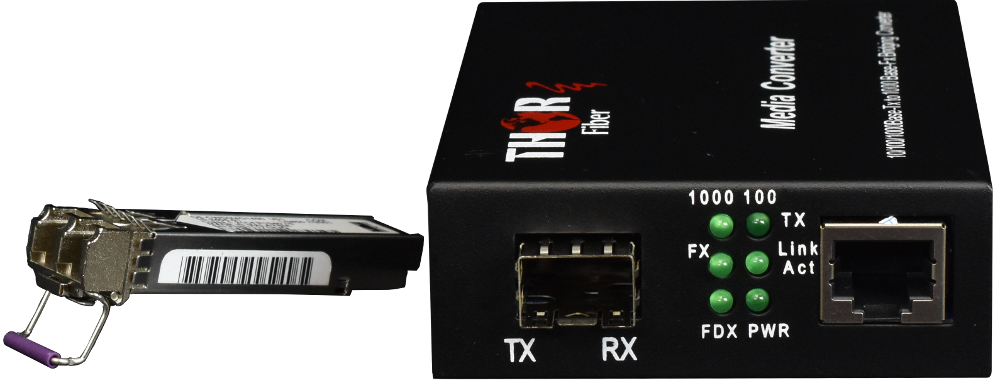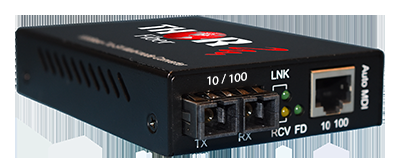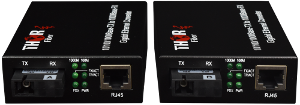Ethernet Extender over fiber SFP Media Converter. Fiber to Etherent converter with SFP
Features
• 1000 Mbps Full Duplex Gigabit Ethernet Over Fiber Transceiver
• 1 x 1000BASE-FX LAN Fiber Port (multimode or singlemode optics)
• 1 x 1000BASE-FX WAN Fiber Port (singlemode optics 1310, 1550, CWDM, DWDM)
• 110km Transmission Range
• 1 or 2 Fiber Strand Transmission
• Full wire-rate 2000 Mbps Duplex Transmission for greater network performance
• Plug-n-Play Gigabit Ethernet Mode Converter or Singlemode Repeater
• IEEE 802.3z compliant
• Guaranteed Switch performance and hardware compatibility with other switches, hubs, and adapters
10/100 Mbps Ethernet to fiber media converter. Ethernet Rj45 to duplex SC fiber singlemode up to 20km 40Km 80Km Single mode or multimode fiber
Features
- All Converters comply with IEEE 802.3 & 802.3u Fast Ethernet Standards
- LED Indication: Power, FDX, TP 100, TP Link/Act, Fiber 100, Fiber Link/AC
- 10/100Mbps Auto Negotiation
- Auto cross over for TP port
- Support Link Alarm
- Support Switch mode & Pure converter mode
- Dual Port 10/100Mbps Switch inside
- Metal Case
- External Power Adapter
- 200mb/s in Full Duplex
Ethenet Extender Bi-Directional 10/100/1000 Gigabit Ethernet over one fiber.
Features
- All Converters comply with IEEE 802.3 & 802.3u Fast Ethernet Standards
- LED Indication: Power, FDX, TP 100, TP Link/Act, Fiber 100, Fiber Link/AC
- 10/100/1000 Mbps Auto Negotiation
- Auto cross over for TP port
- Support Link Alarm
- Supports Switch mode & Pure converter mode
- Dual Port 10/100Mbps Switch inside
- Metal Case
- External Power Adapter
- 1000Mb/s in Full Duplex
This device is a point-to-point 4 Gigabit Ethernet bi-directional fiber optic converter. It converts standard RJ45 electrical Ethernet signals for transmission over fiber optic cable, enabling long-distance communication up to 120km

Features
-
Key Features
-
Point-to-point bi-directional transmission over a single (simplex) fiber
-
Zero-delay automatic forwarding
-
Auto Speed negotiation
-
Full Duplex
-
Transmits 4 ports of 10/100/1000 Mbps Gigabit Ethernet (10BASE-T / 100BASE-TX / 1000BASE-T)
-
4 x RJ45 connectors (auto-negotiated, unmanaged switch)
-
Supports single-mode, single-fiber via LC connectors (simplex)
-
Transmission distance: 20km standard (40km, 80km, or 120km available depending on model)
-
Hot-pluggable modules
-
Available in chassis mount, wall-mount, or DIN-rail configurations
-
1500W surge protection and 15kV ESD protection
-
External power supply
-
Wide operating temperature range: -40°C to +70°C
-
Input voltage: 9 ~ 48VDC
-
Reverse polarity protection
-
Compact form factor
EMI, RFI, and Surge Immunity
Electromagnetic interference (EMI) is common in industrial plants, warehouses, and factory floors. It can corrupt data over copper-based Ethernet links. In contrast, fiber optic transmission is completely immune to EMI, RFI, and ground loop issues ensuring clean, reliable data communication.
By using fiber, you eliminate problems caused by voltage equalization currents and electromagnetic noise, enabling more stable and reliable network performance, especially in electrically noisy environments.
What is optical fiber?
The history of optical fiber dates back to the mid-nineteenth century, however, this technology in its present form became commercially available only in 2000, when the Internet started to become widely available around the world. The optical fiber is a data carrier made of fiberglass. It is used in many fields related to both science and everyday life. Its great advantages are the range and bandwidth of the transmission which are higher than in the case of other transmission media. The optical fiber has conquered the Internet also because it is resistant to electromagnetic interference and atmospheric conditions, and enables fast data transmission over long distances. Copper on the other hand has always been limited to distance and bandwidth. So long haul and large data rates meant that copper couldn't solve problems that fiber can.
What is Ethernet?
Ethernet is one of the most popular technologies used to create local computer networks (LAN). Ethernet was developed in the 1970s and entered the commercial market in the 1980s. There is a huge difference between early versions of Ethernet and its modern form. In the past, the Internet speed of 1 Mb / s was amazing, but today Ethernet has much more to offer:
- 10 Mb / s versions
- Fast Ethernet - 100 Mb / s
- Gigabit Ethernet - 1 Gb / s
- 10 Gigabit Ethernet – 10 Gb / s
Fast Ethernet is now one of the most popular standards, but it is being gradually replaced by Gigabit Ethernet. What else should you know? Data in the Ethernet network is sent through a cable called twisted pair cable. In the case of Ethernet, you will have to use twisted-pair cable Cat 5, Cat 5e or Cat 6.
Why should I buy Fiber to Ethernet converters?
Obviously, you can use optical fiber or Ethernet cable in most applications. Sometimes, however, an individual, company or institution wants to provide Internet to buildings that are located far away from each other. Where is the problem? If you use Cat 5 or Cat 6 cables in your building, you can send data only up to a distance of 100 meters. Optical fiber cable can be several dozen kilometers long (or more for long haul). In addition, it provides high-quality data transmission with almost no interference. If you decide to buy fiber to Ethernet converters, you can connect the buildings, while also using your Ethernet cables already installed.
This type of converter is a perfect solution for local LAN networks, university campuses, buildings of one company that are not located close to each other. The converter will allow you to connect cameras to a recorder device mounted in another building or room. Many manufacturers offer also use converters for individual consumers. They will help you provide Internet to a garage or workshop as well as connect two or more locations in your house or office.
How to choose the right optical fiber to Ethernet converter?
The fiber to Ethernet converters market can surprise you with its wide range of the products. However, choosing the right model does not have to be very complicated. All you need to do is answer a few questions:
• What is the distance between buildings / rooms? There are two basic types of optical fiber: multimode and single-mode. Multimode fibers are up to 2 kilometers long, while single-mode fibers are over 2 kilometers long. If you plan to connect two buildings which are more than 2 kilometers away from each other, then buy a converter with single-mode fiber input. This type of cable will allow you to send data over distances of more than 2 kilometers. However this type of broad advice maybe subject to the hardware you select in you installations. Make sure you check out the distance options on your converters, as well as the optical loss in the fiber itself. Fiber that is properly installed will be sujected to loss, or relections cause the signal to disintegrate faster then it should.
• How many strands of glass does the optical fiber have? Both single-mode and multimode optical fibers may have one (simplex) or two (duplex) strands of glass. Simplex has one channel and enables communication in one direction, while duplex has two channels and enables communication in two directions at the same time. Check also the relation between the type of optical fiber and the speed of transmission:
- simplex multimode optical fiber: 100 Mb/s
- duplex multimode optical fiber: 1000 Mb/s
- simplex single-mode optical fiber: 100 Mb/s or 1000 Mb/s
- duplex single-mode optical fiber: 100 Mb/s or 1000 Mb/s
How does it work?
The operation and use of the fiber to Ethernet converter should not cause problems even for people who do not know the first thing about the modern technologies. All you need to do is connect the cable ends to the proper places in the transmitter and receiver. The conversion starts automatically. It's simple, isn’t it? It is also possible to connect more end devices. In order to make it possible, you have to buy a compatible switch and connect it to the receiver and end devices. For example the vast majority of devices created in this relevant field are simply plug and play, require a small amount of power, and are compact for easy installation in discrete locations.

 ES
ES





